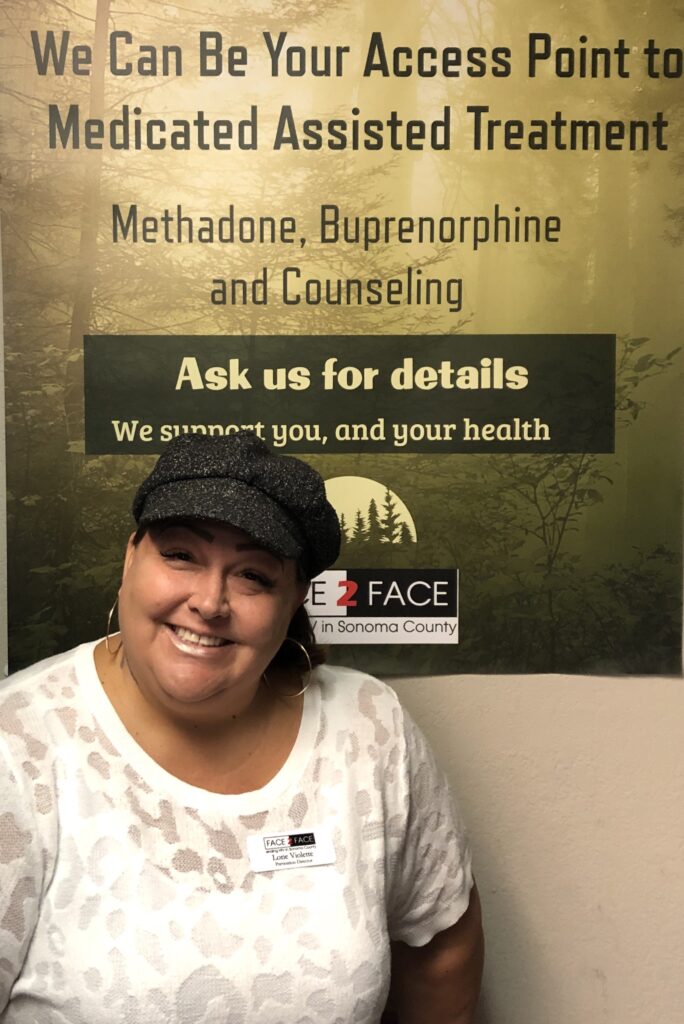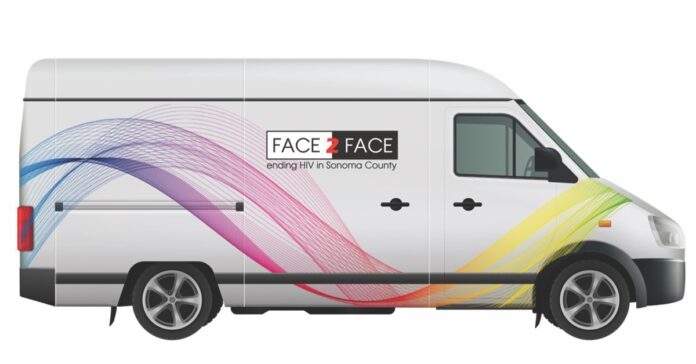The plan is elegant in its simplicity: If the people can’t get to the care, bring the care to the people. This is essentially the thinking behind a new initiative at Face to Face, Sonoma County’s HIV/AIDS services network, which has launched a $250,000 capital campaign to fund a mobile-services unit.
Dubbed “On The Move,” the campaign’s anticipated result is an electric van chockablock with everything the organization needs to deliver its HIV/AIDS prevention and care services throughout the County. Monies raised will not only launch the project but fund it for 24 months after its inception.
“With this electric van, we will be able to reach further into the communities we serve to provide HIV testing and harm reduction services as well as provide more care services to our clients who are living with HIV and can’t make it into our offices,” says Executive Director Sara Brewer.
The van will also provide something else to the organization—visibility.
Due to advances in medical care, an HIV diagnosis is no longer an imminent death sentence, which may contribute to lax attitudes about managing the potential for infection. Moreover, in recent years, the Covid pandemic has absorbed much of the media’s coverage of health issues, pushing HIV/AIDS further to the back burner.
“But AIDS still happens, and it happens here in our community,” says Face to Face Development Director Gary Saperstein. “We can bring awareness to our community that this still does exist, and hopefully by seeing this people will maybe go to our website and they’ll read about it and find out what’s going on.”
He adds, “All the services that we provide are hopefully leading us to ending HIV in the County—that’s our mission. Great strides have been made in HIV over the years, but it’s still not over. People are still getting HIV, people here—but you don’t hear about it as often.”
Legacy
Face to Face first offered services in the early days of the AIDS crisis in ’80s-era Guerneville. Now in its 39th year and based in Santa Rosa, the nonprofit organization continues its mission to end HIV/AIDS in Sonoma County.
In 2021 alone, Face to Face performed 452 HIV tests; introduced 25 new clients to PrEP 211, an HIV-preventative medication; helped house 15 clients; served 182 clients with financial assistance and benefit counseling; provided 6,325 Naloxone kits, which help in reversing drug overdoses—of which 3,780 were reported; not to mention exchanged 810,00 syringes and retrieved 735,500.
Since launching On the Move in a “quiet phase” prior to the public roll-out last February, the campaign has raised over $60,000. Once all the monies are raised, an electric van will be purchased and retrofitted to match the organization’s unique needs, including partitioning the cargo space into private rooms to conduct its confidential services. HIV tests will be available in the van, as well as consultations, needle exchanges, condoms, educational material and, as Saperstein says, “Everything that pertains to our mission”—including a staff of compassionate professionals.
“The people who work at Face to Face are so passionate about the work that they do,” Saperstein says. “I don’t think I’ve ever worked with people more passionate about what they do. They impress me and amaze me every day.”
Road Tested
In some ways, Face to Face has already conducted a proof-of-concept for the mobile unit.
“During Covid, our harm prevention director, Lorie Violette, literally took her car, emptied out her trunk, put all the supplies in there and went out there in the community,” Saperstein says. “It’s pretty amazing, doing that work. This is why we need the van. We saw it work, and the need for it, during Covid.”
The population Violette serves often faces a bevy of challenges, from housing and mental health challenges to the lack of safe spaces for people who use drugs and are unhoused to go and receive services.
“If someone asks me for help of any kind, I would find out what they are looking for, assess readiness and either provide a linkage or referral. I would follow up with them as well. We plant a lot of seeds here at Face to Face, and that is why we are unique,” says Violette, who points out that Face to Face’s harm reduction services are currently drop-in. “Folks just come up to the door; we welcome them and ask what supplies would they like to get today. It’s a low-barrier service, with a non-judgmental approach. One of the most important aspects is that people can be themselves and feel cared for. They also get what they need to be safe.”
Saperstein affirms this notion. “It’s not about judgment—we’re here to help you if you want help,” he says. “We can link you to care. We can find the ways to help you, but you have to help yourself first. You have to take that first step.”
By bringing its services to those it serves, Face to Face hopes to make that first step even easier.
Learn more at www.f2f.org/on-the-move
[SIDE BAR]


One aspect of combating HIV/AIDS is predicated on the concept of “harm reduction.” Face to Face’s Harm Prevention Director Lorie Violette shared what this means in practical terms with Bohemian editor Daedalus Howell.
Lorie Violette: Harm reduction is reducing any harm related to substance use—or really anything; brushing our teeth, seat belts, eating a salad rather than a hamburger—while treating people with dignity and respect. Showing compassion and meeting people where they are at, not where we think they should be at. Example, someone shows up for supplies, they are having a hard day. Instead of me saying, “Well, if you stop using drugs your life may get better,” a harm reductionist would say things like, “I’m glad you came in today. All that you’re going though, you still made a point to come in and get supplies. That’s awesome. Would you like to chat a bit?” Harm reduction is not ignoring the issues at hand. It’s just not forcing people to do anything or using any kind of coercion.
Bohemian: When it comes to managing issues around scenarios like intravenous drug use or unprotected sex, how does harm reduction apply?
Violette: It would all come down to, what does that person want to do? Do they have the right information about risks, and are they asking me for my expertise? If so, I would ask them, what was successful in the past? Are they aware of PrEP 211? Do they need any supplies to stay safe?
Bohemian: How will the van integrate into your current harm reduction programs?
Violette: The van will allow Face to Face to go directly to the people, and provide our services. Some of the most vulnerable community members can’t get to us. We will reduce stigma associated with HIV, people who use drugs, overdose—while serving our community. These kinds of things need to be talked about. We cannot pretend they don’t exist, and we need to make sure our community has the facts.











